|
COVER STORY, AUGUST 2005
THE RISING TIDE OF FLORIDA RETAIL
Retail development looks skyward as once-plentiful land becomes scarcer in the Sunshine State.
Patti Connor
With available land fast dwindling and costs skyrocketing for the limited amount that remains, Florida developers in the early part of the 21st century find themselves going head-to-head with new, though perhaps not entirely unexpected, challenges. Their dilemma represents a radical departure from those halcyon days of 1 or 2 decades ago, when retail development was at its most fertile and developers in the Sunshine State could rest easy knowing a more-than-ample supply of wide-open, buildable ground was theirs, virtually for the asking.
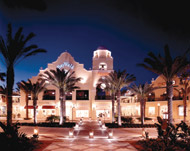 |
The Sembler Company is developing BayWalk in St. Petersburg, Florida.
|
|
Those days are gone. Nowadays, developers have little choice but to make do with what little space is left to them. “The limited amount of available space has definitely been instrumental in driving prices through the roof,” says Doron Valero, president and CEO of Equity One in Miami. “Twenty years ago, buying land was a no-brainer. Now if you look at Dade, Broward and Palm Beach (counties), or for that matter even as far north as Jacksonville, the land’s just not there.”
The problems don’t end there. As land has continued to dwindle, construction costs and costs of labor and materials have risen proportionately. Until fairly recently, what cost between $60 and $80 per square foot goes for between $100 and $120 today. “That’s a huge increase — and one that has affected the industry significantly,” says Valero.
As a result of these combined factors, developers are finding themselves having to adapt as never before. Certainly, the impetus to do so is there. With its reputation as a vast, sun-splashed playground largely untarnished by such unsettling developments as last year’s rash of hurricane activity, the Sunshine State continues to attract new residents in droves (on a daily basis, some 1,000 people relocate to the state). In fact, it’s predicted that by 2020, Florida will hold the distinction of being one of the top three largest states (by population) in the country, exceeded only by New York and California. That prospect, of course, bodes well for developers.
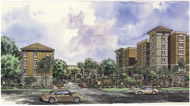 |
RMC Property Group’s Broadway project currently is under construction in Sarasota.
|
|
In 2004, the total number of visitors to Florida numbered more than 76.8 million. On a yearly basis, total tourism-related spending exceeds $56.5 billion. With its steady growth, temperate climate and continuous infusion of disposable income, industry insiders feel confident Florida’s development climate, from a retail standpoint, can only get hotter. Among other factors, the state’s cost of living continues to work strongly in its favor. According to Mike Fimiani, vice president of Woolbright Development in Boca Raton, “Relative to states like California, real estate in Florida is still fairly inexpensive. Despite the recent run-up of prices, you still can find affordable housing and commercial space — it just may not be on the water.”
Valero agrees. “Look at all the things Florida has going for it. Beautiful beaches. No heavy traffic. And, especially when compared to New York and L.A., a relatively inexpensive cost of living. It’s hardly surprising that [the] growth rate is phenomenal.”
Hot Markets
So, which areas are booming? More to the point, perhaps, is which ones are not. “Every market in Florida is hot right now,” says Michael Leeds, president of RMC Property Group in Tampa. If, in fact, the entire state is on fire, certain portions are all but off the charts. Most unexpected is the emergence of “sleeper” markets that until recently no one thought much about. “Jupiter, the Panhandle, the Treasure Coast, Tequesta, Stuart, Vero, Fort Pierce, even downtown Palm Beach — areas no one even talked about a few years ago — those markets now are awake and screaming,” says Lyle Stern, president of Koniver Stern Group in Miami Beach.
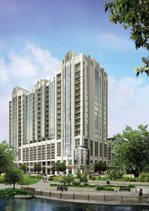 |
RMC Property Group is under construction on the Paramount, a mixed-use project in Orlando.
|
|
John Crossman, a principal with Trammell Crow Company, agrees. “The Panhandle, especially, is a market to watch,” he says. “For years it was on no one’s radar; now it’s on pace to be one of the fastest growing areas of the state.”
The Villages, just south of Ocala, is another area to keep an eye on, notes Crossman. Located about an hour north of Orlando, “It’s not only one of the fastest growing areas in the country, but it matches perfectly with national trends as they place increasing focus on active retirees. With the next wave of baby boomers turning 60, The Villages should be a very active market for potentially the next 2 decades.”
Interestingly enough, Florida’s formerly dormant markets are restricted to no one particular area; rather, these rapidly growing areas extend from one side of the state to the other. In South Florida, downtown Hollywood is enjoying new popularity as a result of its central location between Fort Lauderdale and Miami. Rod Castan, director of leasing for Courtelis Company in Miami, says his company is beginning to see a lot of interest, as well as new projects in the planning stages, in once sleepy areas such as Homestead, Miramar, St. Lucie County, Eastern Collier County, Cape Coral and Estero in Southwest Florida. “In the Tampa area, Pasco County is the market everyone is talking about. In Central Florida, Clermont and Lake County are generating discussion, as are Ocala, Gainesville and surrounding areas,” he says.
Florida’s diversity as a whole makes the state a virtual mecca for retailers. There are not only a plethora of upscale markets, but also there are rural and suburban areas similar to other parts of the country. Median ages throughout the state are trending younger. The Latin influence felt throughout much of the state opens new brand-doors for offering specialty goods. Also, golfing communities are on the rise, changing the profile of the “typical” Florida homeowner as baby boomers reach retirement age.
Southeast Florida in particular has become a magnet for developers — and for retailers — for the same reasons the area has become an increasingly desirable place to live for out-of-towners relocating to the state. As contrasted with the Northeast and its brutally long, cold winters, the area’s climate is temperate year-round (discounting, of course, summer hurricanes).
“You’ve got incredible opportunities in real estate, a rapidly growing and improving education system, and people who make a lot of money and like to shop,” says Craig Menin, president of Menin Development in Palm Beach Gardens.
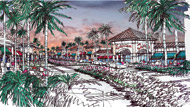 |
Opus South’s Shoppes of Gulf Coast is underway in Fort Myers. The 245,000-square-foot center is expected to open in fall 2006.
|
|
Needless to say, all this bounty comes at a price. Developing in Florida carries its own special set of challenges. In the next couple of years, developers can expect to find themselves staring down the barrel of what well may be their biggest obstacle yet: how to deal with the labyrinth of growth management issues that have arisen as an inevitable result of the state’s massive population expansion.
“By 2030, Florida’s population is projected to double,” Crossman says. “When you take into account that we’re not only surrounded by water on three sides but we’ve also got the Everglades to contend with, the amount of land we have is restricted.”
Florida developers must also contend with various barriers to entry. Along with the customary habitat and wildlife issues that accompany development of a vacant tract of land in the Sunshine State, many of those barriers, of course, are similar to what developers face in states in most other parts of the country: infrastructure, the government approval process (including MUSP approval) and the cost of providing traffic mitigation and contributing schools to roadways, etc.
“The permitting process used to be much easier. Although it varies from city to city, it can now be extremely lengthy and difficult. Developers who think they can come in and pull a permit in 3 months are in for a rude awakening,” cautions Valero.
So, the question remains: how can developers best capitalize on all of Florida’s various advantages and, at the same time, work within the framework of the not-inconsiderable constraints they’re facing? By altering their approach to what’s gone before. In the next few years, expect to see a dramatic increase in vertical and mixed-use development as builders, hampered by a lack of land, focus their efforts on building skyward. Certainly, with dilapidated buildings and warehouses sitting on prime downtown real estate, they have at their fingertips a made-to-order forum for mixed-use opportunities to support the residential demand in the state’s growing downtown markets.
What’s fueling that growth? Says Valero: “More and more, people are saying, ‘Wait a minute, we want to be urban,’ or ‘We want to live closer to work.’ We’re also seeing a lot of empty nesters who are tired of life in the suburbs and like the idea of having a place they can lock up for 3 months and go and travel.”
Successful Retail
Fimiani is among those who feels confident that well located grocery-anchored centers will continue to be a strong asset class. Of the lifestyle centers that in recent years have proliferated, “They are new and exciting, and they will, I think, continue to draw attention,” he says. With one caveat: “Until the concept is perfected, I anticipate we’ll be seeing some failures.”
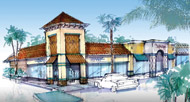 |
In Orlando, Trammell Crow Company’s Vista Promenade will open first quarter 2006.
|
|
Stern agrees. “The [key] is having well thought out, well anchored centers that are true and consistent to an approach — i.e., compatible fashion with appropriate level of dining experience.”
Certainly, with competition at an all-time high, it’s no longer enough for centers simply to offer a sterling lineup of tenants. In order to attract — and keep — consumers’ business, there must be an attendant share of bells and whistles as well.
Menin says his company has found what appears for them to be a winning combination: “Combining some of the characteristics of a typical grocery-anchored neighborhood center with some of a lifestyle center, then adding elements such as fountains and really good landscaping seems to be a great choice right now,” he says. That scrupulous attention to detail pays off in ways that are double-barrel. “Today’s hot retailers and restaurants want to be part of a unique environment. They’re looking to locate in a center with more character and ambience than [one finds in] your traditional enclosed mall,” notes Menin.
There also will be a continued redevelopment of existing centers. Woolbright is among those working on refurbishments throughout the state’s major metro markets. The company owns just under 3 million square feet of centers; another 1 million feet is in the pipeline, either under contract or being negotiated.
Notable Projects
Woolbright’s recent projects include The Collection at Vanderbilt in Naples, a new 250,000-square-foot upscale shopping center opposite the Ritz Carlton Golf Resort. Anchored by a Fresh Market, the project will encompass 160,000 square feet of shops and 50,000 square feet of restaurants. The projected opening date for Phase I is early 2006. In addition, the company recently purchased Glades Plaza in Boca Raton. To be located across from the Town Centre Mall, the project encompasses 180,000 square feet. A redevelopment plan will be implemented over the next few years.
Waterstone Plaza, a mixed-use project developed by Equity One, opened in Homestead in July. Anchored by Bank of America and Walgreens, the center features a Pollo Tropicale restaurant and 20,000 square feet of local shops.
In Pasco County north of Tampa, Equity One is developing a mixed-use project on State Road 54 and Sun Lake. Along with residences, the 150-acre project will encompass approximately 300,000 square feet of retail. The project will be anchored by a supermarket, with approximately 11 outparcels remaining. Completion is targeted for 2007.
Dan Herman, vice president of development of Developers Diversified Realty in Beachwood, Ohio, foresees that in South Florida, products of choice in the next few years will include hybrid shopping centers featuring a mix of big box retailers in a traditional layout. Also remaining desirable, according to Herman, will be lifestyle tenants in a main street concept. He says mixed-use developments remain the most desirable product choice.
 |
Equity One’s Waterstone Plaza opened in Homestead, Florida, in July.
|
|
Under redevelopment in Hollywood is Hollywood Circle, with existing tenants that include Publix, Walgreens and Washington Mutual. Upon completion, projected for late 2008, the vertical mixed-use project, developed by Equity One, will encompass two apartment towers, with 80,000 to 100,000 square feet of retail housed underneath. In addition, downtown Hollywood is working to bring in independently owned (as well as chain) stores. During the next 3 to 5 years, various developers will construct some 300,000 square feet of new retail space as part of condominium projects designed to attract the chains downtown.
Courtelis Company has several significant retail projects underway. One is Deerwood Town Center, located at Florida Turnpike and Coral Reef Drive in Miami, with 280,800 square feet anchored by The Home Depot and OfficeMax, projected to open in spring 2006. Other Courtelis projects include Magnolia Square, located on Pine Ridge and Goodlette Frank Road in Naples, anchored by a 150,000-square-foot Sweet Bay Grocery with tenants to include Starbucks and Crispers, opening spring 2006; Ave Maria Town Center, a 65,000-square-foot retail town center as part of the new Ave Maria University and community east of Naples under development by Barron Collier Company and leased by Courtelis; Shops of Sandoval, on Veterans and Surfside in Cape Coral, a 210,000-square-foot mixed-use project under development by Dodge Capital and leased by Courtelis, with opening set for late 2006.
Developers Diversified Realty is developing The Shops at Midtown Miami, a 634,000-square-foot center with major tenants Target, Circuit City, Ross Dress For Less, Linens ‘n Things, West Elm and PetsMart, opening in 2006; and Homestead Pavilion, a 400,000-square-foot center projected to open in 2007 in Homestead.
Under development by Opus South is Shoppes of Gulf Coast, a 245,000-square-foot center at I-75 and Alico Road in Fort Myers, which will include department stores, a supermarket, home improvement and discount clubs. Projected opening is fall 2006.
Sutton Management’s The Reserve, an upscale 145,000-square-foot center in Boca Raton, has been open for about a year. The center is anchored by Publix and many boutique tenants. Sutton currently is looking for an upscale restaurant to tenant an available end cap space with outdoor seating to complete the center.
New Plan Excel Realty Trust is developing Leesburg Square in Leesburg (Lake County) — which company officials call “one of Florida’s faster growing areas.” The International Super Buffet-anchored center adjoins a Wal-Mart Supercenter. Other projects include Colonial Marketplace, adjacent to Fashion Square in Orlando, anchored by OfficeMax; other tenants include L.A. Fitness, Chipotle, Pei Wei, Plato’s Closet and Jason’s Deli. In Jacksonville, New Plan is busy with Regency Park, a new power center adjacent to Regency Square Mall, anchored by Babies “R” Us, Marshalls, Books-a-Million and Michaels. Finally, in New Port Richey, New Plan is renovating Southgate to coincide with the opening of a new 44,841-square-foot Publix.
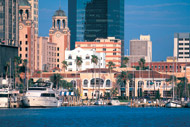 |
A view of the St. Petersburg waterfront.
|
|
Menin Development also has several significant neighborhood and regional retail centers in the pipeline. Downtown at the Gardens will be a 350,000-square-foot open-air upscale specialty center anchored by a 16-screen Cobb Theater and a 42,000-square-foot Whole Foods Market, including more than 60 specialty retailers, three full-service valet locations, concierge services and a museum-quality sculpture park that will run throughout the center and around what ultimately will be a lake park. Completion is set for November 2005. Menin also is underway on neighborhood centers in Port St. Lucie, Jupiter, Palm Beach Gardens, West Palm Beach, Coconut Creek and Sunrise/Weston. Anchors include Publix, Winn-Dixie, Sears Essentials, Regal Theatres, Staples, Pier 1 Imports and Marshalls.
Koniver Stern also has several significant projects under development. Whole Foods Plaza at Pembroke Pines will be anchored by Whole Foods when it opens in January 2007, while Metropolitan Miami, a mixed-use project also anchored by Whole Foods, will include 220,000 square feet of retail space and 1,500 condominium units in downtown Miami. It is expected to open in January 2007. Also in downtown Miami, Mary Brickell Village is anchored by Publix, Bally Sports & Fitness, P.F. Chang’s, Rosa Mexicana, Starbucks and Oceanaire. In Davie, the Shops at Downtown Davie will open in January 2007. Tenants at the 50,000-square-foot center include Starbucks and Quiznos.
St. Petersburg is experiencing a renaissance of its existing core retail centers. As the center is already built out, several developers have been commissioned to consolidate multiple locations to accommodate one project. In the past, the City of St. Petersburg has engaged a number of public/private partnerships to facilitate new developments in downtown St. Pete. Notable examples include BayWalk, a total retail project by The Sembler Company, and the Progress Energy-Grand Bohemian Hotel site, Progress Energy’s new corporate headquarters location and a four-star Westin Hotel with residential.
CASTO LIFESTYLE PROPERTIES: THREE KEY PROJECTS
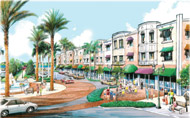 |
Main Street at Lakewood Ranch is underway just north of Sarasota.
|
|
Casto Lifestyle Properties, based in Sarasota, Florida, is under construction on three retail projects that are set to open this November. At Lakewood Ranch, the 28,000-acre master-planned community just north of Sarasota, Casto Lifestyle Properties is underway on Main Street at Lakewood Ranch, a mixed-use project including 120,000 square feet of retail, 46,000 square feet of second-floor office space and 64 condominiums. Some of the residential units are above the retail, and there is a freestanding condo building as well.
“This lifestyle property is unique because it’s in the interior portion of a master-planned community, and not on a major artery or road,” explains Brett Hutchens, president/CEO of Casto Lifestyle Properties. “The only national tenants we have for the project are Chico’s and Ritz Camera; the development is anchored by Gourmet Grocery, and we have three tablecloth restaurants in addition to the best of the best in terms of local and regional retailers.”
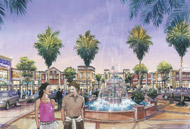 |
The 500,000-square-foot Lakeside Village is scheduled to open in Lakeland in November.
|
|
In the southern part of Lakeland, Casto Lifestyle Properties is developing Lakeside Village, a 500,000-square-foot retail project anchored by an 18-screen Cobb Cinemas, Bed Bath & Beyond, a 74,000-square-foot Belk and one of the first Kohl’s in Florida. The development is being constructed in a main street village format, and it features other tenants such as Talbot’s, Chico’s and Coldwater Creek, and restaurants including Chili’s and Macaroni Grill. Lakeside Village is set to open in mid-November.
Casto Lifestyle Properties’ third project, Whole Foods Market Centre, is a redevelopment of a 3.18-acre city block in downtown Sarasota. A Whole Foods Market opened in December 2004 at the site; in addition, Casto built a four-story parking garage that is surrounded by 23,000 square feet of retail space and 95 condominiums.
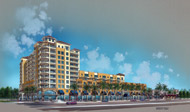 |
Whole Foods Market Centre is a redevelopment of a 3.18-acre city block in downtown Sarasota.
|
|
“In general, we’ve directed our business toward mixed-use based on the experiences we’ve had,” says Hutchens. “There’s a real synergy among retail, residential and office, and it all relates to convenience. In beginning to focus more on residential in our mixed-use projects, we’re trying to prepare ourselves to meet the demand for growth. In addition, we think that creating residential with retail amenities creates place and value that wouldn’t be present in a strictly residential development.”
Depending on the type of project, everywhere in Florida is a hot zone for development. According to Hutchens, grocery-anchored strip centers are popping up everywhere in the state, but especially in terms of larger projects with lifestyle centers and residential components, central and southwest Florida are the places to be.
— Dan Marcec |
TURNBERRY HELPS TURN THE RETAIL TIDE
Turnberry Associates, based in Aventura, Florida, is underway on several significant expansions and projects in Florida. In Destin, the company developed Destin Commons this year, and now it is adding 136,000 square feet to the lifestyle center. However, the biggest project in the state of Florida that Turnberry has undertaken is in its hometown of Aventura at the Aventura Mall. The company currently is adding 140,000 square feet to the development; when all is said and done, the expansion will move the project from 2.4 million square feet to 2.7 million square feet.
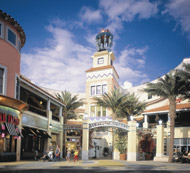 |
Turnberry currently is expanding Aventura Mall in Aventura, Florida.
|
|
“Generally, if you know Turnberry on the lifestyle side, we look for the upper-crust retailers across the country; and in Aventura, our expansion is the pick of the litter,” says Drew Barkett, executive vice president of retail development and real estate for Turnberry Associates. “Aventura is an amazing project where we’re not only doing an expansion, but we’re reinvesting approximately $20 million for a complete renovation of the shopping center, which is one of the largest in the country. We’re very bullish on it.”
The lifestyle center trend is here to stay, and recently, there has been a big push for developments of this sort. Especially in Florida, the warm, sunny weather plays such a large role in influencing the demographics of retail shoppers, so the outside centers are very popular.
“Especially in the Miami-Dade area, we’re seeing a lot of vertical retail development,” says Barkett. “Traditionally, boxes shy away from urbanized areas where land values are prohibitive, but in these areas, if you want to develop a traditional power center or lifestyle center, you’re forced to go vertical on it; so that’s a neat, interesting project type that’s come across lately, not only in the Miami area but also along the Gulf Coast.”
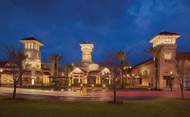 |
Destin Commons opened this year in Destin, Florida.
|
|
Up and down the east and west coasts, the whole state is reinventing itself, and land values are strong — thereby increasing the opportunity for development. Florida is a vibrant market, and now more young people are moving into the area as well. In fact, with close to 100,000 new residents flocking to Florida every year, the entire state is alive, and the boom in residential growth directly correlates to the creation of new retail. The weather is favorable not only for residents, but also for shoppers and tourists, drawing a host of retailers to the area.
“Americans love to treat themselves, and shopping is a part of Americana,” adds Barkett. “The retail development is so vibrant throughout the state, and I’m happy to find anything of quality anywhere in Florida; Turnberry has focused a lot on quality development in the past few years, and we plan not only to double but hopefully to triple our size during the next couple of years.”
— Dan Marcec |
GOODMAN COMPANY: GOING STRONG IN FLORIDA
West Palm Beach, Florida-based The Goodman Company is the master commercial developer for Wiregrass Ranch, a 5,000-acre mixed-use development located in the Tampa, Florida, area. The entitlements for the project will be complete next year, but some of the retail projects within the ranch already are underway. Overall, Goodman has laid plans for approximately 2.5 million square feet of retail within the development.
“The most notable component that Goodman is developing in Wiregrass Ranch is a joint venture project with Forest City Enterprises,” says John Dowd, senior vice president of development with The Goodman Company. “The 750,000-square-foot lifestyle center features three department store anchors; JC Penney already is under construction, and in mid-2006, we expect to break ground on the balance of the project, which includes Dillard’s, another department store to be announced, and then about 300,000 square feet of inline restaurants and shops.”
 |
The Shops at Wiregrass Ranch will be part of a 5,000-acre master-planned community in Tampa.
|
|
Goodman’s development, The Shops at Wiregrass Ranch, also boasts an entertainment complex, which features a movie theater, other entertainment-oriented tenants, and some outparcel and restaurant users. In addition, a Wal-Mart Supercenter will break ground within the next couple of months, and a 400,000-square-foot power center is on its way as well.
“Developing in Florida is unique because of the challenges it presents,” adds Dowd. “Throughout the state, almost every site has wetlands issues or storm water and drainage issues, and any project encompassing more than 400,000 square feet is subject to a Development of Regional Impact (DRI) process, which we currently are undertaking at Wiregrass Ranch.”
Basically, a DRI processes through a local regional governing body; for example, the Tampa Bay Regional Planning Council controls DRIs in the Tampa area. These regional planning councils observe and project what impact the development will have on the surrounding four- or five-county area, and in effect, they will call for more impact improvements and onsite improvements in order to ensure the project aspects are addressed from a more regional perspective.
“Developing in Florida is not for the faint of heart or the faint of wallet; a DRI will cost $1 million and last about 18 months,” Dowd explains. “However, Florida is such a vibrant market and there aren’t really any barriers to entry; on top of that, roughly 1,000 people move to the state every day, covering all markets and regions. And the tourist factor cannot be ignored.”
— Dan Marcec |
CONTINENTAL REAL ESTATE COMPANIES HAS FLORIDA COVERED
Continental Real Estate Companies (CREC), with its headquarters based in Miami and satellite offices in Miami, Orlando and Jacksonville, Florida, currently is developing two prominent projects in Florida. In Coconut Creek, CREC is constructing the Coconut Creek home furnishing center, which will be anchored by an 80,000-square-foot Eldorado Home Furniture. Upon completion, the two-story center will encompass approximately 150,000 square feet.
“Everything in the project will be peripheral uses for home furnishing, which makes it very unique,” says Steven Henenfeld, senior associate with CREC. “Eldorado is the main anchor tenant, and the center will feature a junior anchor as well.”
 |
Hawk’s Crossing is under redevelopment in Coral Springs.
|
|
CREC also is undertaking the redevelopment of Hawk’s Crossing in Coral Springs. Currently, a dark Winn-Dixie and about 20,000 square feet of shop space are on the site, and the company plans to raze the entire project to build a 173,000-square-foot SuperTarget. In addition, the redeveloped center will include roughly 100,000 square feet of ancillary retail space. Delivery for the project is planned in 2007.
“One of the most unique challenges of developing in Florida recently has effected from the devastating hurricane season we had last year,” says Sabrina Meerbott, senior leasing associate with CREC. “Permitting and construction costs already are high, and the rebuilding of houses are given priority in the counties and municipalities.”
While this challenge is short term, many developers have trouble finding contractors because there is so much work to be done across the entire state. The barriers to enter the retail market are not stringent, as developers from everywhere are taking advantage of the booming market and the demand for new retail is so high. However, the residential growth and the redevelopment initiatives effected from hurricane damage has made construction more difficult.
“Another thing that has added pressure for developers is the resistance we see from neighbors,” Meerbott adds. “For example, so many people are moving to the area, and when big boxes such as Target, Home Depot, Lowe’s Home Improvement Center and Wal-Mart are proposed, residents often are in opposition due to the spatial issues these developments present.”
CREC has only recently entered into the development side of the business in the past 18 to 24 months. While development is something the company has done very little of in the past, it is seeing the opportunity the state of Florida has to offer. Including the two undertakings in Broward County, CREC now is forging ahead on the development side of the Florida retail market.
— Dan Marcec |
©2005 France Publications, Inc. Duplication
or reproduction of this article not permitted without authorization
from France Publications, Inc. For information on reprints
of this article contact Barbara
Sherer at (630) 554-6054.
|
